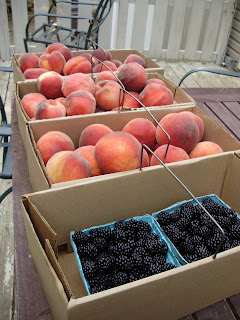This one is for Mimi cuz she's a honey...and really knows how to bake with it. So I thought I'd show her how honey is harvested.
Here is where all the magic happens.. the secret world of beez.
It all starts with the beez. The beez are out there hard at work - they live in hives that we built or bought. Aside from getting them into the hive and some general maintenance there's not much to do but let them buzz around. While there is a ton of "futzing" you can do - we don't. This holds to our general rules of "less is more" and "natural is best" so we don't over manage the beez.
Beez hard at work in the hive.
If you are lucky, and have productive beez, you can get up to three harvests a year in our area. Our hives are new so we had our first harvest this week...and are hoping to harvest after the first frost which will be about mid-October. The beez need something to eat this time of year so we are letting the weeds go wild - especially the ragweed which we are both allergic to and blooms like the dickens this time of year. The honey made with this pollen will help our immune systems next year (hopefully) so we won't be so allergic to it. And frankly, I wasn't looking forward to yanking up all them weeds so it works out very nicely.
Back to the harvest. I stood in the safety of the house while The Big Man suited up and went and got the "supers" which are the parts of the hives that hold the honey. And no, I ain't helping him. Everyone has their limits and this is mine. I stood in the house clutching the dog and my can of Raid just in case any of them beez came for me.
The supers hold the frames which contain the wax structures that house the honey. We have both wood and plastic frames.
These are the wood frames....
And the plastic frames.
For the other "beeks" (the buzz for "beekeepers") out there, we found that the beez (and us!) preferred the wood frames with wire supports. The plastic ones were hard for us to work with and the beez built the combs between them and in weird structures. We'll get more wood and wire frames for next year.
The first step is to cut the tops of the wax structures off to release the honey.
See the sealed combs below the knife?
We set up a plastic tub with a wire rack to hold the wax that we cut off. This allowed us to collect any honey that dripped out of the wax caps.
We didn't do a great job with cutting the caps off with the knife. So we used a fork to rake the combs and this worked really well.
Then the frames went into the extractor - which is really just a tall tub with a salad-spinner-like-thing that flings the honey out of the combs and lets it collect at the bottom of the tub. We loaded up the frames and...
Wood frames in the spinner
...just started crankin'...
Folks with lots of hives have power extractors... we just cranked it by hand.
Once we had enough honey in the bottom of the tall tub, we set up the double strainer which removed all of the wax and debris from the honey. We filtered it into a big bucket with a valve on the bottom so it could be easily poured into containers.
See the honey in the bottom of the tub? The valve locks and unlocks easily.
It was so exciting to see all that lovely liquid gold come rushing out!
This was definitely the best part!
And the leftover wax was pretty interesting also...
We collected all the wax - the bits and the bigger chunks of comb to use later.
Altogether we harvested almost 5 gallons of honey from just one hive out of the two "supers" by using the extractor. Then we let the extra wax drain and got even more honey. We'll let the honey set for a couple days to allow all the air bubbles to release and then we'll put it into smaller containers. It's gonna be mighty tasty on home made biscuits!
While we were thrilled with our progress, of course, it turned out to be a big sticky mess. We learned a few things:
1. Doing this outside with a bunch of angry beez probably wasn't the best idea. I finally had to relent and let the stickiness into the kitchen after them beez came lookin' to get their honey back.
2. Working inside with a bunch of over-interested cats wasn't that much better of an idea.
3. Putting the cats up and THEN working inside was the right answer. Several of the cats kinda got stuck together...but then again, so did we! Yikes!
Pretty much everything got sticky...and just when we finished and went to bed promising ourselves we'd clean up the mess the next day... the electric went out for most of that day!
But the house smells heavenly (still) and now that I have the electric back on (finally!) I'm gonna see what I can make with all this honey. My pal, DM, suggested
these lovely honey cupcakes...and someone else suggested goat's milk 'n peach 'n honey ice cream... I'm wonderin' if Mimi has something special she can suggest?
Happy honey everyone! Remember that local honey is good for lots of reasons!



























































